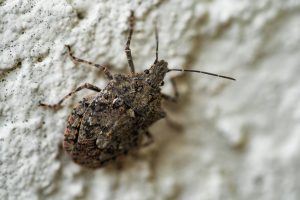STINK BUGS CONTROL

Stink bugs, also referred to as the yellow-brown or East Asian stink bug, are one of the most common pests in the fall; they start seeking out warmth and protection for the winter. This is considered an invasive species, as they were introduced to the United States from Eastern Asia in the mid-1990s. It has since spread throughout most of eastern and western North America. The stink bug earned its name from its tendency to release an odor when disturbed or when crushed. They are shield-shaped and brown, with two antennae and a set of wings.
Not sure if you have a stink bug problem? Or maybe you want to learn more about how stink bug control works. Check out the following information to clarify some questions you may have.
Library Shortcuts
- Should I be concerned about Stink Bugs?
- Signs of a Stink Bug infestation
- Why do I have Stink Bugs on my property?
- Can I get rid of Stink Bugs myself?
- Tips to prevent Stink Bugs
Should I be concerned about Stink Bugs?
Stink bugs are more of a nuisance than a threat to people; they cannot sting and are not likely to bite, but caution should be used when handling them to avoid a release of their unpleasant odor, which some people may be allergic to. They do not cause structural damage or spread disease. However; stink bugs are a threat to the agricultural industry, they are capable of destroying a variety of plants due to their feeding on them. They suck the juice from the leaves, stems, and roots of plants. They can damage ornamental plants, fruit trees, crops, and gardens.
Signs of a Stink Bug infestation
During the late summer months and autumn, when the temperatures change; your home can become vulnerable to a stink bug infestation. Look for the signs listed below to help you identify an infestation:
- Live or dead stink bugs sightings; if you have spotted a live stink bug in your home, you may be experiencing an infestation, as they are known to invade structures in large numbers. You will usually see them on the warm sunny sides of your home. You will commonly see dead stink bugs around frequently used entry points, like doors, window frames, chimneys, etc.
- Stains; stink bugs leave trails of excrement behind wherever they crawl; the trails are dirty yellow or brown stains that can be found all over your windows, the walls, and across your kitchen countertops.
- The stink; stink bugs release a foul-smelling odor when threatened or handled. They secrete a foul-smelling liquid from a specialized gland, which is their defensive mechanism to discourage predators from eating them. If they are inside your home, the more stink bugs you have and the longer they stay, the stronger the smell will become.
- Damage to house plants; when stink bugs come into your home for the winter; you will start seeing damage to your vegetable plants and fruit trees.

Why do I have Stink Bugs on my property?
Stink bugs are common invaders within residential homes. Like many other pests, stink bugs look for shelter in late summer and early fall for their overwintering phase, a period in their life cycle where they are inactive, they do not feed, and do not reproduce.
Since stink bugs are about the size of a penny, they don’t need a giant hole to enter homes or any human-made structure; they find entry points between cracks and crevices around the exterior and can even pile into them by the thousands. When stink bugs locate a suitable location to diapause, they release an aggregation pheromone that attracts other stink bugs to the site they have found. Once temperatures outside rise, they will start looking for ways to go back outside so they can feed and mate.
Can I get rid of Stink Bugs myself?
Getting rid of stink bugs indoors can be a chore because of the unpleasant odor they release when squashed or disturbed, but there are some methods you can try to control a small infestation:
- Capture and release; you can attract stink bugs into a jar or bottle with light and then throw them outside or place them in a sealed container in the trash.
- Vacuuming; remove live and dead insects from your home by vacuuming them; if you do this with stink bugs though, your vacuum might smell bad, so empty it as soon as possible.
- Drown them in a bucket or pan partly filled with soapy water.
- Spray them with a combination of hot water, dish soap, and white vinegar.
Tips to prevent Stink Bugs
The best way to avoid seeing these critters in spring is to keep them from finding a winter home on your property. Try the following tips to prevent them from infesting your home:
- Seal all entry points; inspect the outside of your home for easy access points around windows, doors, utility pipes, etc. and seal any cracks and holes; you can use caulk as needed.
- Repair screening; check for holes or damage to the screens on doors and windows and repair or replace them. Make sure they fit tightly into their space.
- Light sources; stink bugs are attracted to lights like many other insects, so keep them off or change exterior lighting to less-attractive yellow bulbs or sodium vapor lights, or motion-activated lights.
- Essential oils; some essential oils like mint may repel stink bugs and other winter pests due to their aroma.
- Diatomaceous earth; this natural sedimentary rock containing silica, alumina, and iron oxide will keep stink bugs away.
- Garlic; stink bugs can’t stand garlic odor, you can create a spray or spread garlic cloves on window panes.
- Cut off food sources; store food in airtight containers and dispose of garbage regularly and clean all counters and floors.
- Landscape; keep branches and shrubbery well-trimmed and make sure to store firewood at least 20 feet away from your property.

Want a Free Estimate?
Need to Schedule Service?
Have a Questions?
WHAT WILL WE DO?
Our stink bug control process typically consists of the following stages:
- Confirm or discard the existence of stink bugs in your home through an inspection.
- Identify the factors that may be causing and contributing to the infestation.
- Offer pest control programs to get the problem under control.
- Treat the existing population and prevent future infestations.
What our clients are saying
Our Partners and Awards
Service Areas
New Jersey:
Ocean County
Essex County
Passaic County
Morris County
Hudson County
Bergen County









